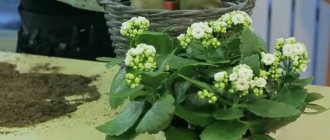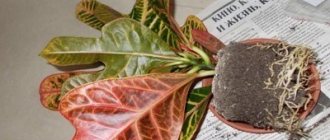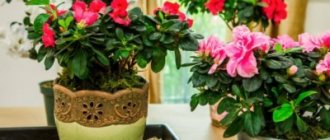When is a transplant needed?
The plant really needs replanting. As the roots grow, they gradually fill the container where it lives. There are several cases when a transplant is required:
- roots appear from the drainage holes and extend beyond the pot;
- the plant is sick, depressed, and loses its decorative properties. The leaves turn yellow, fungal infections are detected;
- the appearance of pests in the soil, including the possibility of egg laying;
- The old pot has become unusable.
Begonia in bloom
In some cases, the plant has not yet reached large size, but the pot was found to be completely filled with roots. This means that the time has come to change the container. Begonias that have not yet mastered the entire capacity and are healthy are not transplanted.
There is another case when replacing the pot is necessary. The flower is provided with another pot and fresh soil. The begonia plant needs replanting after purchase. It is not recommended to rush through the procedure, but in a store-bought container the plant will sooner or later wither.
Plant in winter
Evergreen species have a weak dormant period. Tuberous varieties require a long period of dormancy. Caring for begonias in winter depends on the species. Bush and ornamental plants should be installed in a place where the temperature is 15-22 degrees and high humidity.
From mid-autumn, the tuberous species prepares for dormancy. The leaf plates dry out and die, so you need to water it less. After the above-ground part dies, the containers with plants are moved to a cool room (10-15 degrees) for the whole winter.
Sometimes tuberous plants are not prepared for dormancy, then they are forced to do so. Otherwise, next year there will be no lush flowering. In this case, watering must be reduced, and the part of the plant that is above the soil must be cut off.
How does begonia reproduce? This procedure is performed by seed or vegetative method. The second option is simpler and faster. It is easier to propagate begonia from cuttings. Each of them has its own characteristics.
How often to replant begonia?
How to transplant a ficus at home to a new place
The transfer of the plant from the old container is planned in early spring. This choice of time of year is the most correct, because growth processes are just beginning to intensify. At this time, the indoor flower will endure the procedure and recover with minimal losses.
Important ! With excessive growth of the root system, the risk of injury increases. This situation cannot be allowed to happen.
Experienced gardeners believe that changing the container and soil should be made an annual event. This is due to the fact that the soil becomes depleted over time. The plant is given the opportunity to restore its composition, replenishing it with the necessary nutrients. It is better not to forget about the regularity of the procedure in order to avoid death.
It's time to replant the begonia
There is another important question: is it possible to replant begonia that is currently blooming? This should be done only after the flowering process is complete. Then the procedure will be safe, otherwise the flowers will begin to fall off. There is a possibility that the plant will lose its decorative qualities, taking on a sickly appearance.
Features of the begonia root system
The structure and functioning features of the root system is the first aspect that needs to be taken into account when preparing a plant for replanting. On this basis, many varieties of indoor begonias are divided into three types:
- Tuberous. On the lower part of the stem, at the very root collar, such plants form a growth in the form of a spherical, and subsequently flat-round tuber. A branched root system is formed in its lower part.
- Rhizomatous. They form fleshy, horizontally located rhizomes with numerous small roots. The rhizomes are pubescent and bear leaves with stipules.
- Root. It has a branched root system without pronounced modifications.
The roots of all types of begonias are located mainly in the upper layers of the soil, grow wider rather than deeper, are thin and are easily injured if handled carelessly.
The rhizomatous root system is more common in decorative leaf varieties, and the tuberous root system is more common in flowering varieties.
How to choose a pot and soil?
How to transplant an orchid to a new place
A competent choice of container and soil will be the key to health for begonias. This is the most important factor in the question of how to replant begonia. You need to make sure you have everything you need before the transplant event. The list of components is as follows:
- a suitable pot should not be overly large. Young begonias are transplanted into containers that are 3 or 4 cm larger in diameter than the previous ones;
- The material of the container is important. They prefer ceramics, although plastic is also suitable for creating the necessary conditions;
- When deciding how to plant begonia, for each part they take containers 2 or 3 cm smaller than the previous one. When separating the rosettes, the original plant is left in its original container. Technological pots have a size of 6 by 6 cm;
- soil mixture of suitable quality. This is a mixture of peat, turf, humus and ordinary soil in equal proportions;
- drainage as the basis for comfort. They take expanded clay, crushed stone, pieces of foam plastic and other materials.
Having prepared the listed components of the process, they begin to transfer the plant to a new place of residence.
Begonia in a new pot
Important ! The shape of the next pot should not create additional difficulties. For example, if the edges are curved inward, it is easy for pests to hide there.
Blooming begonia is not replanted
Soil disinfection
There is one nuance in the question of how to properly transplant begonia at home step by step. It is important to disinfect the soil, which will ensure the absence of pests that can attack the plant from soil infested with larvae. It is convenient to use an ordinary microwave oven for the procedure.
Plant selection
If you don’t want to grow a flower, then at the end of spring you can buy it with formed buds. It is important to pay attention to the color and size of the plant. You also need to consider appearance. Spots and insects are signs of an unhealthy plant. It's not worth buying.
The inspection must be carried out carefully: the stems and leaves must be turned over, the pot must be shaken and the soil must be crushed. These actions allow you to determine compliance with watering and moistening conditions. After purchasing, the pot must be moved to the shade and treated with chemicals. If you choose the right begonia and follow the rules of care, it will delight you for many years.
If you purchase a tuber, you need to pay attention to the size. It is important that it is at least 4 cm in diameter. A healthy plant should have pink or white buds.
Preparing for transplant
When to dig up crocuses - transplant to a new place
The ceramic (or other) pot in the house is thoroughly washed. It is recommended to soak the clay version in water for a day and then scald it with boiling water. Plastic needs to be cleaned under running water and detergent. And also at the preparation stage, soil and drainage must be available.
Begonia in boxes
Landing
The pot must be filled 1/3 with drainage material. Then 2-3 cm of charcoal is placed on it, which is required to protect it from rot. You need to place a flower with a lump of earth in the container, and then you just need to fill the voids with the earth mixture. After planting, the plant is watered.
Planting should be done in the spring from the second half of March, when the illumination and daylight hours are suitable for growth. When the plant is tuberous, it requires germination. To do this, the tubers must be placed on a substrate in a box and placed in a well-lit, cool (16-18 degrees) place where the humidity is 60-70%.
Transplant methods
Two methods are possible: complete and partial transplantation. The first case refers to the purchase of a new plant or when diseases or pests are detected. Actions should be carried out as follows:
- Expanded clay is poured onto the bottom of the prepared pot;
- by pouring charcoal in the next layer, it will be possible to prevent rotting of the roots;
- drainage is covered with 2 cm of soil;
- Begonia can be easily removed from the previous container if you water it, turn it over or tilt it, and tap it a little;
- shake off the old soil. It won't hurt to wash the roots in a weak solution of potassium permanganate. Damaged and dead parts are removed;
- The plant is placed in a new container, holding the stem, and covered with fresh soil. The root collar is not buried.
All that remains is to lightly compact the soil. Although when watering, shrinkage will occur by itself, after which you just need to add more soil. The transfer method is applied to a healthy plant into a larger container. This is a gentle mode. Having moved the begonia along with the earthen lump into another pot, add fresh soil to the free space. This method only partially renews the soil.
Begonia transplant
Application of fertilizers when transplanting begonias
Some gardeners, trying to help the plant survive the transplant, make a serious mistake - they begin to fertilize the begonia almost immediately after the procedure. This is strictly forbidden. The root system is extremely vulnerable during the post-planting period, and even small doses of fertilizers can damage it.
The first feeding of begonias after transplantation can be carried out no earlier than signs of rooting appear - new shoots and leaves. This usually happens in about a month. You can feed the plant with one of the following compositions:
- "Garden of Wonders Begonia";
- "Bona Forte for violets and begonias";
- "BiOPON Begonia";
- “Agricola Aqua for indoor plants” [wp-svg-icons icon=”file-word” wrap=”i”] Read reviews from gardeners about Agricola fertilizer.
It is better to apply half the recommended dose for the first feeding. Subsequent ones follow the usual pattern.
Care after replanting a plant
When properly caring for begonia, you need to take into account its light-loving nature. Active growth will be observed under intense but diffuse lighting. Immediately after transplantation, the pot is placed on a western or eastern window. Other rules are set out in the following list:
- exclusion of drafts;
- the temperature cannot be too low: from + 15 in winter and + 18-20 degrees in summer. Its stability and absence of changes are important;
- if diseases are detected, treatment is started immediately, otherwise the plant may be lost;
- in winter additional lighting will be required;
- Watering is done correctly, to which the flower crop responds well. Use only soft water, and remove excess water from the pan in a timely manner;
- Feeding applied on time (2 times a week) will help strengthen the immune system against diseases. The store has a range of fertilizers for begonias or indoor flowers. The dose is reduced by half.
The watering scheme requires special attention. Its frequency in summer should be at least 2 times a week, and in hot weather - every day. With the onset of autumn, by October the soil is moistened as its top layer dries. In winter, the frequency does not exceed twice a week. From March the amount of moisture increases. It is better not to spray the plant; unhealthy spots may appear. Maintain humidity by placing the pot on wet peat or pebbles.
Rules for growing begonia at home
The plant prefers fertile, light, breathable, loose, slightly acidic soil (acidity level pH 5.5). Buy ready-made soil in the store or make it yourself.
It includes:
- leaf soil (2 parts);
- peat (2 parts);
- sand (1 part);
- compost (1 part).
Begonia at home
You can add a handful of coniferous soil. To reduce acidity, fluff lime, dolomite flour, and wood ash are used. To make the soil looser, add coconut fiber and vermiculite.
Additional Information! For planting, take a clay, ceramic or plastic flowerpot. The first two absorb moisture well, which means the soil does not dry out longer. However, the roots of the plant can grow to the walls of such pots.
Lighting, temperature
Begonias need space and a lot of light. It is best to place the pot with the plant on the windowsills of east or west windows. In the summer, it is necessary to shade the flower from direct sunlight using newspapers, cardboard, curtains, and blinds. In winter, plants need to be exposed to the sun, as well as additional lighting with phytolamps or daylight fixtures.
Note! Begonias need fresh air. It is necessary to ventilate the room where the flowers are located every day. However, plants should be protected from drafts.
In summer, the comfortable temperature for plants is +20 - 22 degrees. In winter, the temperature should be +15 - 18 degrees. A temperature drop below +14 degrees or, conversely, an increase above +26 degrees can lead to the death of the plant.
Begonias need space and a lot of light
Humidity
It is necessary to provide flowers with high air humidity (at least 60%). Take a wide tray and place an inverted saucer in it, on which there is a pot of begonia.
Important! It is unacceptable to spray begonias. Brown spots appear on the leaf blades from drops of water.
Expanded clay, pebbles are poured around the stand, or moss and peat are placed. Moisten generously. Place the plant back on the plate. Periodically add water to the pan.
You can humidify the air around the begonias using a spray bottle, place containers of water, an aquarium, or a decorative fountain next to the bushes.
Watering
From spring until autumn, water the plant abundantly and often (at least 3 times a week). The top layer of soil must dry to a depth (1.5 - 1.8 cm). In hot summers, watering is carried out daily. Take settled water at room temperature. Once every 10 days, complex minerals are added to the irrigation water.
Important! Begonia does not like soil that is too wet or too dry.
Water the root begonias along the edge of the container. Drain excess water from the saucer. You can place the pot (for 15 minutes) on a dry napkin or cloth so that the liquid is absorbed. Irrigate the tuberous plants in a tray. Reduce watering for winter. In winter, water once every 7 - 9 days.
Watering begonias
Top dressing
Fertilize every 2 weeks when buds begin to form, as well as during flowering. Flowering crops are fed with phosphorus-potassium substances. Nitrogenous compounds should not be used, as the plant may not bloom. Fertilize decorative foliage flowers with nitrogen fertilizers.
Reproduction
Begonias are propagated in several ways:
- Seeds. Sow the seeds on moist soil and press them slightly into the ground. Cover with a bag and keep warm. After 2 weeks, shoots should appear. When leaves form, plant the seedlings into cups.
- Cuttings. Cut off the petioles (length 10 cm). Remove the lower leaves and cut the upper leaf blades in half. The cuttings are buried in the ground up to the leaves. Cover with plastic bottles. They will take root in a month.
- Leaf. Cut a healthy leaf into segments. Each fragment must have veins (1 - 2 pieces). Stick the pieces cut-side into damp soil and cover with a glass or bag. When young shoots appear, they are transplanted into containers.
- By dividing a bush or tuber. Divide the plant or bulb into several parts. Sprinkle the cut areas with crushed coal. Each plot should have one bud or eye. Planted in different pots.
Begonias are propagated by leaves
Replanting after purchase
The rules for replacing the container with which the plant was purchased are similar to those outlined above. Planting can take place immediately. But it is not recommended to rush too much. The best solution is to wait for two weeks or a month. And if flowering is observed, the procedure is prohibited until it ends. The container size is usually left the same.
Typical mistakes during transplantation
An unsuccessful event can lead to the death of the plant. The following errors are indicated:
- The size of the new container is incorrectly selected. If the size is too large, the soil may turn sour and the roots will deteriorate;
- the soil is heavy, its permeability is insufficient, there is a lot of peat. All this provokes stagnation of water. Too much acidity (over 6.0) is also harmful;
- the root collar was buried, although it should have been left in its original position. Then the plant will rot.
Attention ! Good drainage is very important.
A home gardener will not need much effort and time to transplant begonias. The most important thing is to take care of the roots. Otherwise, it will be quite difficult for the plant to take root in a new place. Creating comfortable conditions is necessary, because only then will flowering occur.
Hot chocolate capsules Nescafe Dolce Gusto Chococino, 8 servings
334 ₽ More details
Nesquik Opti-Start instant cocoa drink, 250 g (package)
125 ₽ More details
Happy birthday balloons
Features of the plant
In addition to the existing about 1 thousand species, there are approximately 2 thousand hybrids of this plant. Therefore, there is no average description of this flower. In addition, plants are decorative-flowering and decorative-deciduous, deciduous and evergreen, perennial and annual, creeping and tall, root-like and tuberous.
Flower growers grow many species of this plant. At the same time, everyone requires approximately the same care. Begonia propagation is also carried out in similar ways. It is important to follow the rules of care, and then the plant will delight you with beautiful flowers.











